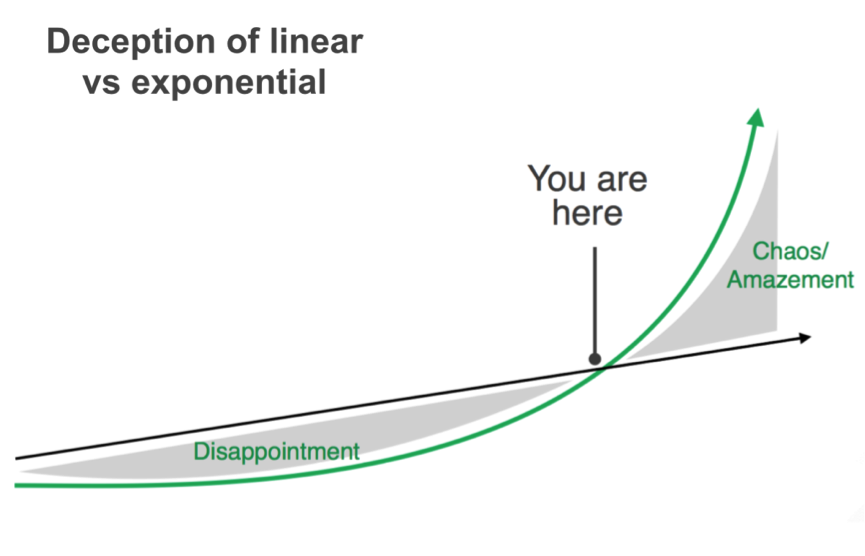![nistlabtomarket (1)]()
One of the ways to think about product evolution, the evolution of marketing and communications, or perhaps more accurately, the evolution of the overall customer experience is through “push and pull” strategy. This is explained, specifically in a marketing context, very well here.
In 2007, Marc Andreessen, co-founder of Silicon Valley venture capital firm Andreessen Horowitz, wrote “In a great market - a market with lots of real potential customers - the market pulls product out of the startup.”
Much has been written about the failures of pushing whole products and product messages to unsuspecting, potentially uninviting markets, with the expectation that “meaning” and “value” to the customer were things you could define through a set of assumptions and effectively deliver through a solid plan.
In fact, this is the very premise through which The Lean Startup and similar methodologies were conceptualised. Most products still find their beginnings through vision or insight, but rather than building the entire product, we build the minimal thing (i.e. the minimum viable product or MVP) that will enable us to validate the accuracy or inaccuracy of our assumptions. We then use this learning to drive our next assumption and set of tests.
As Eric Ries, author of The Lean Startup (2011), writes, “We must learn what customers really want, not what they say they want or what we think they should want.”
The key thing here is learning, not dictating. We now actively engage in constant learning; learning about behaviours, about needs and about beliefs. Our ability to learn what we need to about the customers we aim to serve is driving the change or evolution I refer to.
This evolution of products and experiences, at least in chronological terms, started with us - the people building and marketing products - pushing whole products to markets. Think Don Draper. Sometimes this worked and sometimes it didn’t. We then began building products for people, people that existed within markets, and those people proceeded to pull the products they genuinely wanted directly from us.
The result of this, at least for many large enterprises, was a shocking revelation or “turn of the tide” as it were, where the customer or user became the boss. This turn of the tide, for some organisations, resulted in flipped org charts with the customer on top and the CEO at the bottom, challenging the assumptions about not only what products we should or shouldn’t build, but how we should interact with our customers throughout the entire customer journey.
At this moment, we are on the cusp of a move right back to push, where we once again take parts of the burden of choice away for the user. This may sound contrarian, however, the key difference is that this time the push from us to the individual people we aim to serve, within the market we intend (or may not intend) to serve, comes with context.
Context is of course, king.
In the future, the products we build and consume will be made for a market of one. What I mean by this is each and every product will be optimised for one individual person; constantly learning and constantly evolving. Pushing us what we need when we need it.
An early incarnation of this can be seen through Meeco.me, a product that helps everyday consumers define their intent, and build context rich relationships with the brands and products that are meaningful to them. Users of Meeco are part of the early movement towards “market of one” experiences.
My understanding is Meeco users currently do this by defining their intent, however, I believe products like Meeco will begin to predict and push.
Coming back to context, you and I clearly care about different things and we are therefore willing to pay different amounts of money, at different times, for the things that we believe deliver us value. As an example of a current use case, two people may order the exact same product from Amazon, but one of the people has a serious sense of urgency, because they need to use it tomorrow for a specific purpose, and is therefore willing to pay almost whatever it takes to get that product ASAP.
Our context is what sets us apart, drives our behaviour and controls our propensity to pay.
Taking this further, consider the progression of the Quantified Self movement, the Internet-of-Things and Artificial Intelligence (AI). This divergence of market forces and technological capabilities can help us deliver context rich, predictive customer experiences with the user as the primary beneficiary.
What’s really interesting about the journey to this future “state” is that, at times, it feels to be taking forever. But when you think about it, the iPhone was only released in 2007, wearables are only now becoming valuable, and AI (depending on what side of the fence you sit) finally seems to be progressing.
In the words of Chris Dixon, “exponential growth curves seem gradual and then sudden.”
Singularity University frames it slightly differently, stating our perception of seemingly gradual progression is mostly deception. This deception, likely due to time our short-term inflated expectation, often results in disappointment.
This can perhaps be explained more simply using the below image:
[caption id="attachment_44376" align="alignnone" width="865"]
![Deception of growth]()
Deception of linear vs exponential growth. Source: Singularity University.[/caption]
Amara’s Law explains this deception perfectly: "We tend to overestimate the effect of a technology in the short run and underestimate the effect in the long run."
My prediction is that the somewhat linear growth we have experienced is coming to its end, and that exponential growth, as described above, is the phase in which “products for a market of one” can become a technical and commercial reality.
Imagine an interface, with a suite of “things” or capabilities that understand you? I mean really understand you. This “thing” knows what you care about, it understands your intentions, your desires and your goals, and, it helps you figure out the optimal way, each and every day, to achieve the things that mean the most to you.
What’s the market for such a thing? Does it help us achieve our daily jobs, both in work and in life? Does it eliminate fundamental pains or create new potentials for gain? What secrets are waiting to be uncovered? Who are the customers? Is it everyone who currently has a smartphone? How do you interact with it? What does it look like? What does it feel like? What’s the experience and how does the experience differ from you to I? What’s the minimum thing we can build to validate the key assumptions we have about how this changes our experiences, our interactions or our behaviors? When might this become real? Are we way too early to even start thinking this way? Who are the early adopters? Which platforms will it integrate with, or will it create something entirely new?
What do these questions mean? Opportunity. Opportunity to find a secret truth, to ride or even drive this evolution, and create context rich products and experiences that genuinely delight people all around the world.
This is why people like you and I will have work in the future.
Featured image: www.commerce.gov.

 ecoachbuilder.com[/caption]
Currently in beta, eCoach is planned to launch commercially in November, with the standard subscription costing $49.95 per month with no limit on the number of courses a teacher can create; teachers and other educators with an educational email address will receive a 40 percent discount.
With laptops and tablets almost mandatory in today’s classrooms, eCoach isn’t the only platform looking to help teachers and students work better together online, with Smart Sparrow and Blackboard big names in the space.
Though he acknowledges the similarities, Macpherson believes eCoach differs by providing a “consistent shape and form to lessons” through templates which both teachers and students may find easier to follow, which is an important consideration - while teachers are largely getting better at using new technologies, there are still those for whom sophisticated online tools are too difficult to learn how to properly master.
Macpherson added, “The other key difference would be that the time outlay to design and develop an online course would be significantly less when using the eCoach than other tools on the market, such as Smart Sparrow, which require a greater time investment to create content.” Given teachers are notoriously time-poor, this is another important point.
175 teachers have registered to use the platform in beta, with the majority having signed up after meeting the Futura Group at an EduTech conference in Brisbane this year, or discovering the platform through Twitter. The startup will be targeting individual teachers rather than schools, hoping to develop a devoted user base that grows from word of mouth.
Beyond schools, Futura Group aims to grow eCoach into a learning management system for training organisations that want to build and deliver their own courses. Launching in 2016, this platform will have a new feature set and pricing model, based on the number of active users in each calendar month, with a third tier to be developed for enterprise-level users and the HR market.
ecoachbuilder.com[/caption]
Currently in beta, eCoach is planned to launch commercially in November, with the standard subscription costing $49.95 per month with no limit on the number of courses a teacher can create; teachers and other educators with an educational email address will receive a 40 percent discount.
With laptops and tablets almost mandatory in today’s classrooms, eCoach isn’t the only platform looking to help teachers and students work better together online, with Smart Sparrow and Blackboard big names in the space.
Though he acknowledges the similarities, Macpherson believes eCoach differs by providing a “consistent shape and form to lessons” through templates which both teachers and students may find easier to follow, which is an important consideration - while teachers are largely getting better at using new technologies, there are still those for whom sophisticated online tools are too difficult to learn how to properly master.
Macpherson added, “The other key difference would be that the time outlay to design and develop an online course would be significantly less when using the eCoach than other tools on the market, such as Smart Sparrow, which require a greater time investment to create content.” Given teachers are notoriously time-poor, this is another important point.
175 teachers have registered to use the platform in beta, with the majority having signed up after meeting the Futura Group at an EduTech conference in Brisbane this year, or discovering the platform through Twitter. The startup will be targeting individual teachers rather than schools, hoping to develop a devoted user base that grows from word of mouth.
Beyond schools, Futura Group aims to grow eCoach into a learning management system for training organisations that want to build and deliver their own courses. Launching in 2016, this platform will have a new feature set and pricing model, based on the number of active users in each calendar month, with a third tier to be developed for enterprise-level users and the HR market.




















